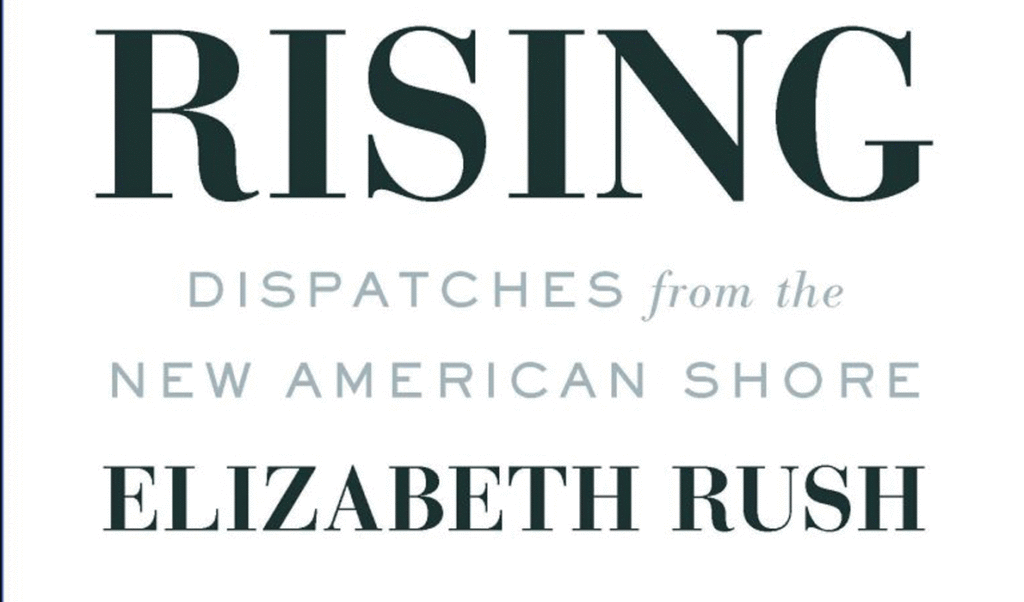Rising: Dispatches from the New American Shore
By Elizabeth Rush (2018; Milkweed Editions)
Reviewed by Tina Cohen
Elizabeth Rush’s Rising: Dispatches from the New American Shore brings readers to places along America’s edges where life is changing. These places are being redefined by rising sea levels, by storms battering coasts, and by disappearing marshland.
Rush teaches writing, currently at Brown University in Providence, R.I. She has also taught at Bates College in Lewiston, and her foray to Phippsburg is one of the book’s vignettes, where a Bates geology professor and several students show her the Sprague River Marsh.
Ditched in the 1930s, a common intervention of the day to drain swampy land and hopefully reduce mosquito populations, it had the unintended result of decreasing many other species as well. Some years later, the U.S. Fish and Wildlife Service started plugging ditches, including those on the Sprague salt marsh, which led to decay and rot instead of a balanced ecosystem. Rush shares the researchers’ concern—of the 131 marshes rimming Casco Bay, 128 were altered.
In order to nurture healthy tidal marshes, good for a number of reasons, they need room to expand; communities and infrastructure built along the seashore would now have to be removed, relocated. When humans have all kinds of different bonds to that built environment—emotional, historical, economic, aesthetic—how do we learn to see and treat the natural ecosystem, impacted by climate change, differently?
Rush is a writer of creative nonfiction. It is a genre that, here, presents factual reportage embedded in a highly individualized, first-person experience. Early in the book she writes, “I begin to suffer from an acute form of anxiety… My faith in natural processes, in the intricate systems of reciprocity that I was raised to believe keep nature from tilting out of balance, is lost. Gnawing uncertainty takes its place.”
This angst leads to wanting to hear first-hand reports from the new frontier: How is it being dealt with, what choices are there? Besides Maine, Rush travels to bayou country below New Orleans, Isle de Jean Charles, La., where the post-Katrina movie Beasts of the Southern Wildwas filmed. To San Francisco Bay and its urban environs. To post-Sandy neighborhoods of Staten Island, New York. Miami Beach and Pensacola, Fla. Forest in Oregon. A tidal marsh of Narragansett Bay, R.I.
Rising might describe the level of anxiety aroused in readers as well as describing the sea level. Fortunately, the way this story gets told gives the reader many reasons to stick with it despite the potential for feeling worried and depressed. Rush can be lyrical in her reportage and reflections. The author undertakes a complex combination: empathy and grief for loss as well as the acceptance that a way forward will have to embrace change. Some things will never again be the same. Her interviews in Louisiana and Staten Island provide great insight into the experience of those who must relocate, and those who resist.
In her last chapter, Rush considers this: “We can move out of the way by choice or else the weather events that we have constructed, are continuing to construct, will make the decision for us. I am not talking about abandoning our lives along the water’s edge, or the wholesale demolition of every seaside property. But I do think the time has come for us to look at the history of our coastal communities and to ask ourselves if rebuilding or continuing to develop in the absolute lowest-lying areas has stopped making sense… When will we know that prevention is not, as it is increasingly framed, an overblown response to an irrational fear?”
Tina Cohen is a seasonal resident of Vinalhaven.





